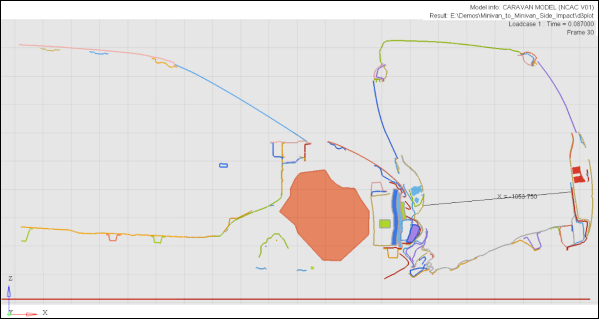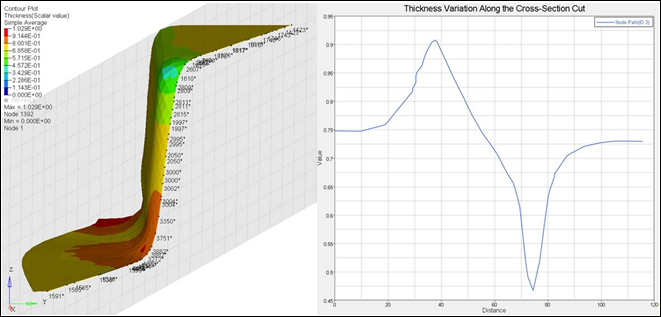Cross-Section Measurements and Path Plots
Measures can be defined on the nodes of a cross-section enabling a deeper analysis of the deformation of the section.

Figure 1.
In addition to making position based measurements on the nodes of a cross section, you can also graph the section or any portion of the continuous segments by defining a node path on the cross-section cuts and cross plotting node X, Y, or Z locations (or the distance between them).

Figure 2.
The nodes on the section cuts are also accessible from the Notes panel to attach any text based annotations to the cross sections.
Cross-section Node Restrictions
- Cross-section nodes are available in the Measure and Notes panel only, and are not available anywhere else in HyperView (for example, in the Quick Query Mode or the Query panel).
- All measure types that accept nodes, except Node path, can have selection from the regular model nodes as well as a mix of cross-section cuts. In a given node path, the start and end points have to be either exclusively model nodes or cross-section nodes, but they cannot be both.
- For paths defined on cross-sections, the start and end points must lie on the same section (as the path algorithm searches based on the initial selection of the cross-section). Multiple paths can be defined on multiple cross-sections as long as the above requirement of start/end on the same section is respected.
- The Multi-select option in the Measure panel is supported for regular nodes from the model only. The selection of cross-section nodes is not allowed.
- Apply Style is disabled for notes and measures defined on cross-section nodes. Applying the settings from a model with notes and/or measures defined on both regular and cross-section nodes to another model, will result in only the notes and/or measures to regular nodes being applied (the definitions on cross-section nodes will be ignored).
- Report Templates are not supported for measures or notes defined on cross-section nodes.
- Copying a model with measures defined on cross-section from one window and pasting to
another location will work as follows:
- The section node path is copied to the target window, if the section cut is turned on and visible in the source window.
- All other measures will be copied from the source to the target window.
- The session must be saved (or exported to H3D) at the same time step at which the section path is created. If the time step is changed before saving/exporting, the node path will not will not get recreated.